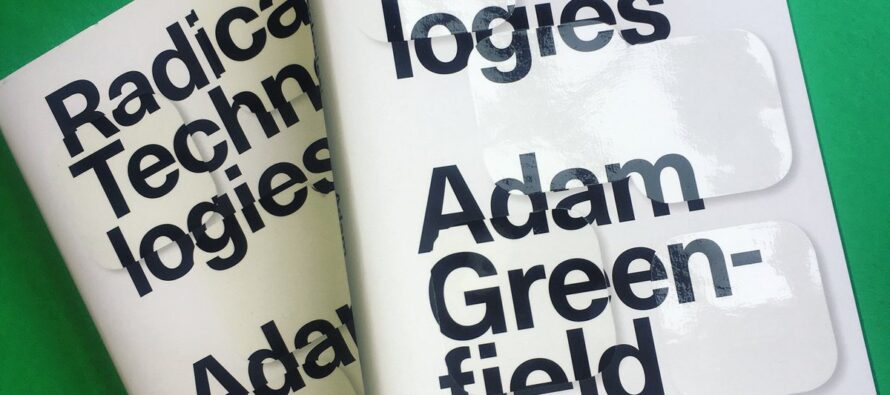BOOK. ‘The Design of Everyday Life’ by Adam Greenfield

![]()
Last June 2017, Verso (formerly New Left Books founded in 1970 by the staff of the New Left Review) released ‘Radical Technologies – The Design of Everyday Life‘ by American writer, Adam Greenfield.
If the 20th century witnessed a litany of revolutionary transformations that crashed, not in their failure, but in the poverty they implemented in their success – then the one place where a successful revolutionary transformation has occurred has to be in the realm of technology (technology meaning “smartphone interconnectedness; augmented reality; digital fabrication; cryptocurrencies; blockchain; automation; machine learning; artificial intelligence, to those-in-the-know). In a time of danger and opportunity (crisis), Greenfield’s book attempts to decipher the code, or more correctly maybe the virus, that this has introduced into our lives with its many pitfalls and dangers. “Radical Technologies itself is a landmark primer and spur to more informed and effective opposition…” the Guardian said, on its publication. We hope…
Adam Greenfield, an American writer currently based in London, is an ex-United States Army’s reserve component Special Operations Command recruit, where he served as a ‘Psychological Operations specialist’. Since his military career ended he has taught at New York University, worked at Razorfish and for Nokia. His 2006 book: Everyware: The dawning age of ubiquitous computing was described as “groundbreaking” by science fiction writer Bruce Sterling: “One puts it down with a strange conviction that web-designers have transcended geekdom and achieved Zen soulfulness.” (Wikipedia) In 2007, he co-authored the pamphlet Urban Computing and its Discontents, an “overview of informatics for urban environments”, and in 2013 released ‘Against the Smart City‘, his critique of multinational corporation led urban planning and development…
Now, 2017, in the ‘The Design of Everyday Life’ he writes:
“In the pages to come, we will explore a wide band of the technologies that are already implicated in our everyday lives, and will be to a still greater extent in the years just ahead: the smartphone and the internet of things; augmented and virtual reality; 3D printing and other technologies of digital fabrication; cryptocurrency and the blockchain; and the dense complex of ideas surrounding algorithms, machine learning, automation and artificial intelligence.”
The book received good reviews by those concerned at the implications of the direction and speed with which the social landscape is currently changing under the influence of these new technologies.
Introducing Greenfield to a New York audience at Columbia University Laura Kurgan, said:
“Everywhere we turn, our everyday experience of the world is being transfigured by the advent of startling new technologies. But at what cost? In this urgent and revelatory excavation of the Information Age, leading technology thinker Adam Greenfield forces us to rethink our relationship with the networked objects, services and spaces that define our lives, as well as the Silicon Valley consensus that is determining the shape of our future. We already depend on the smartphone to navigate every aspect of our daily lives. The technologies that follow in its wake, from augmented-reality interfaces and virtual assistants to autonomous delivery drones and self-driving cars, are offered to us with the promise that they will make life easier, more convenient and more productive. 3D printing promises unprecedented control over the form and distribution of matter, while the blockchain stands to revolutionize everything from the recording and exchange of value to the way we organize ourselves in groups and polities. And all the while, fiendishly complex algorithms are operating quietly in the background, reshaping the economy, transforming the fundamental terms of our politics and even redefining what it means to be human. Having successfully colonized everyday life, these radical technologies are now conditioning the choices that will be available to us in the future, and most of us haven’t even begun to think about what it all means. Just how did they claim such a prominent place in our lives? How do they work? What challenges do they present to us, as selves and societies? In answering these questions, Greenfield’s timely guide orients us to the circumstances we now confront — and prods us to the thought and action necessary to ensure that our values will survive the years to come.”
In the introduction to his book, Greenfield himself tells us:
“But more pertinently, networked digital information technology has become the dominant mode through which we experience the everyday. In some important sense this class of technology now mediates just about everything we do. It is simultaneously the conduit through which our choices are delivered to us, the mirror by which we see ourselves reflected, and the lens that lets others see us on a level previously unimagined.”
As to some of the more hidden implications, The Guardian tells us:
“Greenfield calls all these things “radical” technologies because they could usher in vast changes that lead to very different potential futures: either what is known sexily as “fully automated luxury communism”, or a dystopia of total surveillance and submission to the networks of autonomous computerised agents that might replace human governments altogether.”
And if these possible futures are not bad enough, Greenfield takes a look at what is presently hidden ‘in plain sight’ in that innocuous and ever-present smartphone (or what it really is: “…an aperture onto the interlocking mesh of technical, financial, legal and operational arrangements that constitutes a contemporary device and service ecosystem.”) that is constantly in our hand: “…But behind every handset is another story: that of the labor arrangements, supply chains and flows of capital that we implicate ourselves in from the moment we purchase one, even before switching it on for the first time.
Whether it was designed in studios in Cupertino, Seoul or somewhere else, it is highly probable that the smartphone in your hand was assembled and prepared for shipment and sale at facilities within a few dozen kilometers of Shenzhen City, in the gritty conurbation that has sprawled across the Pearl River Delta since the Chinese government opened the Shenzhen Special Economic Zone for business in August 1980. These factories operate under circumstances that are troubling at best. Hours are long; the work is numbingly repetitive, produces injuries at surreal rates, and often involves exposure to toxic chemicals. Wages are low and suicide rates among the workforce are distressingly high. The low cost of Chinese labor, coupled to workers’ relative lack of ability to contest these conditions, is critical to the industry’s ability to assemble the components called for in each model’s bill of materials, apply a healthy markup and still bring it to market at an acceptable price.”
Likewise, “…the cobalt in its lithium-ion batteries was mined by hand in the Congo, often by children; the tin in the soldered seams that bind it together most likely comes from the Indonesian island of Bangka, where the water table is irreparably fouled, 70 percent of the coral reefs have been destroyed by mine runoff, and on average one miner a week is killed on the job. The damage caused by the processes of extraction fans out across most of a hemisphere, mutilating lives, human communities and natural ecosystems beyond ready numbering. And so the polluted streams, stillborn children and diagnoses of cancer, too, become part of the way in which the smartphone has transformed everyday life, at least for some of us.”
Is the price worth it, we might ask? Eva (a reviewer on goodreads.com) says:
“Our everyday lives are more and more steered and regulated by technologies that are ultimately driven by a desire for profit, control and power. Greenfield’s book stresses the need for a better understanding and more critical thought on these technologies surrounding us… His outlooks are mostly (but not exclusively) pessimistic, which makes sense considering the whole book is meant to be a big warning sign.
Basically – no technology will provide us a magic solution for creating a fair, nondiscriminatory, clean, conflict-free future, and we should all learn to be more critical when new tech innovations appear promising us these utopian futures.
Definitely an important and smart book.”
In the end then: “What seem to be potentially anarchic, liberating technologies are highly vulnerable to capture and recuperation by existing power structures – just as were dissident pop-culture movements such as punk. Greenfield makes this point with particular force when discussing automated “smart contracts” and the technology of the blockchain, a kind of distributed ledger that underlies the bitcoin currency but could be used for many more things besides. “Despite the insurgent glamour that clings to it still,” he points out, “blockchain technology enables the realisation of some very long-standing desires on the part of very powerful institutions.” Much as he scorns the authoritarian uses of new technology, he also wants to warn progressives against technological utopianism. “Activists on the participatory left are just as easily captivated by technological hype as anyone else, especially when that hype is couched in superficially appealing language.” (The Guardian)
After a century of ‘failed’ revolutions (revolutions that so far have failed to radically transform the human condition) it appears, just as the Frankfurt School warned in their flight from the Nazi Holocaust of the last century, that we are potentially entering another Dark Age, but one now where our prisons are pleasurably (and ‘invisibly’) monitored and our compliance and conformism is manipulated by ‘choice’ instead of by armed guards (as John Berger pointed out at the time, watching the violence inflicted on those who chose not to conform – the coalminers who took on Margaret Thatcher in the Miners Strike of 1984-85)… So it appears that the net that is being woven around us now is one of more dark and subtle material than the uniforms, batons and dark glasses, than the thugs and the brutality, the prisons and the covert and often illegal and clandestine operations of the last century….
LSE Cities (London School of Economics and Political Science):
“Having successfully colonised everyday life, these radical technologies are now conditioning the choices that will be available to us in the future, and most of us haven’t even begun to think about what it all means. Just how did they claim such a prominent place in our lives? How do they work? What challenges do they present to us, as selves and societies? In answering these questions, Greenfield’s timely guide orients us to the circumstances we now confront — and prods us to the thought and action necessary to ensure that our values will survive the years to come.”
Adam Greenfield:
“If we are to have any hope of retaining our agency and exerting some measure of control over the circumstances of our being in the years to come, we will need to know a lot more about where these radical technologies came from, how they accomplish their work in the world, and why they appear to us in the way that they do.”
So is the verdict good or bad? And in the end is this technology a tool for human liberation or a weapon of oppression? Greenfield concludes:
“If neoliberalism, like any hegemonic system, produced subjects with characteristic affects, desires, values, instincts and modes of expression, and those subjects came in time to constitute virtually the entirety of the social environment any of us experience, it’s hard to see how matters could be any different in the wake of the posthuman turn. It is exceedingly hard to outright refuse something which has become part of you—and made you part of it—in the most literal way, right down to the molecular composition of your body and the content of your dreams.”
Nevertheless:
“The possibility of resistance offers somewhat more hope. Rare indeed is the oppression so total that there is no scope whatsoever for resistance to it….
If we want to take Marx at his word and steer the world in the direction of justice, though—however we may define it—we need a better, more supple theory of technological change, more suited to a time in which our tools work as networks and distributed assemblages. That theory needs to help us understand how agency and power are distributed across the meshing nodes and links of our collective being, how to evaluate the effect on our lives of that which cannot be understood in isolation and cannot be determined in advance, and how to assemble discrete components in ensembles capable of prevailing over the recalcitrance of things and actually making change.”
Despite the difficulty of Greenfield’s language and concepts, the message is clear: time to wake up. Before it is too late…
séamas carraher
Adam Greenfield’s Speedbird
Greenfield maintains a personal Web site called Speedbird. ‘Clean living under difficult circumstances’
https://speedbird.wordpress.com/
Adam Greenfield’s Bibliography
References:
https://www.versobooks.com/books/2453-radical-technologies
https://www.arch.columbia.edu/events/719-radical-technologies-the-design-of-everyday-life
https://publish.illinois.edu/commonsknowledge/2016/09/29/book-review-the-design-of-everyday-things/
https://www.goodreads.com/book/show/30724899-radical-technologies
https://www.theguardian.com/books/2017/jul/13/radical-technologies-adam-greenfield-review
https://lsecities.net/media/objects/events/radical-technologies-the-design-of-everyday-life
Download & Read (PDF):
Raymond Williams, “Base and Superstructure in Marxist Cultural Theory,” New Left Review, Volume 1, Issue 82, November–December 1973.
“Finally, as Raymond Williams long ago taught us, one of hegemony’s features is that there remain within it always pockets of unassimilated material from social moments past, and the first weak signals of social forms just coming into being. Even if just barely, then, like the ghostly patterns of data left behind on an imperfectly erased hard drive, our arrangements of the world bear traces of lifeways that were founded in solidarity and neighborly conviviality, and an everyday life that was more spacious and tolerant of imperfection. At the same time, if we sit patiently with them, we can sense in certain things around us the slightest premonitory tremble of lifeways yet to be—ways of being human unbound by the tangible and intangible shackles that so often constrained those who came before us. These are the seeds of possible futures, seeds that with effort and care might yet be grown into a wiser, more considered, more just and generous way of living together upon the Earth.”
“Radical Technologies The Design of Everyday Life”, Adam Greenfield, Verso 2017.
Video:
“We need a posthuman politics for a posthuman economy” – Adam Greenfield
https://www.youtube.com/watch?v=EvIjga_sDbY
Is there a coherent ideology at the core of Silicon Valley? Adam Greenfield responds
https://www.youtube.com/watch?v=VwC-Dj6rsP8
Related Articles
Miles de neozelandeses entregan sus armas de guerra a la policía
![]()
El Parlamento de Nueva Zelanda aprobó el pasado abril, por 119 votos a favor y uno en contra, una reforma sobre control de armas, convirtiendo en ilegal la tenencia de armas semiautomáticas
LAS VÍCTIMAS NO SON NÚMEROS. El nuevo número de Global Rights Magazine
![]()
Global Rights Magazine es un lugar en varios idiomas de información, intercambio, reuniones, propuestas, políticas y producciones culturales sobre un mundo que cambia
DTK co-chair and HDP Hakkari MP Leyla Güven took her place in Parliament today
![]()
Democratic Society Congress (DTK) co-chair and HDP Hakkari Deputy Leyla Güven, was sworn in and took her place in the Assembly





